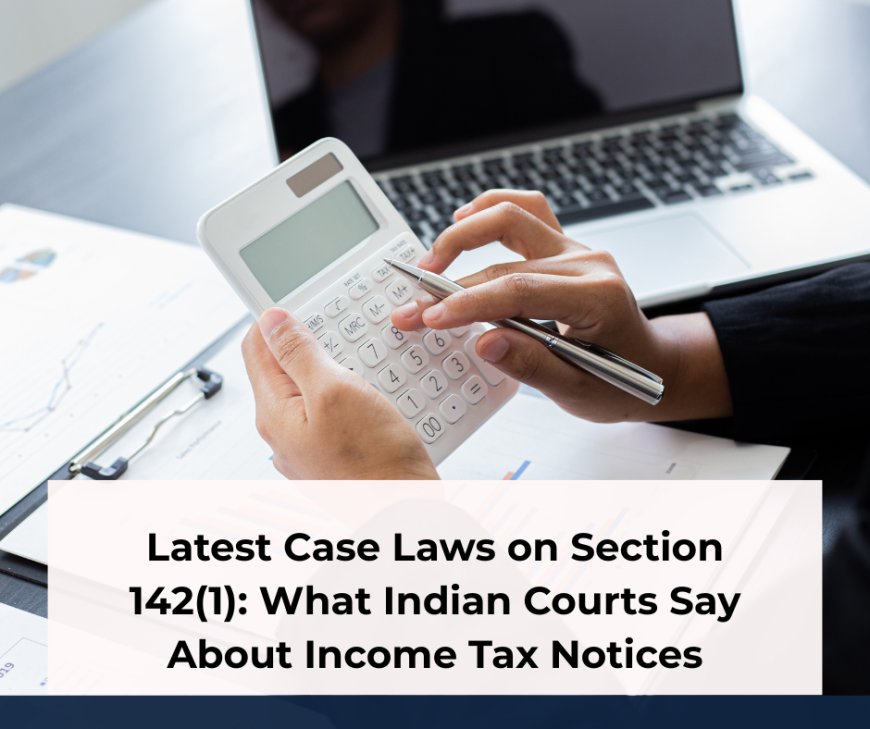Latest Case Laws on Section 142(1): What Indian Courts Say About Income Tax Notices
check that a 142(1) notice clearly lists what’s required, is properly served through the faceless portal, and comes from the right authority; respond on time (or seek extension) and record any service/jurisdiction objections promptly.

Why these rulings matter
Section 142(1) empowers the Assessing Officer (AO) to seek returns, information, or explanations before assessment. Courts and tribunals have recently sharpened the contours around service of notices, specificity, faceless procedures, and penalties. Staying aligned with these rulings helps you respond correctly — and push back when procedure isn’t followed.
1) Service to the correct (updated) email is essential
Kerala High Court (July 2025): If the department sends a show-cause/142(1) communication to an old email after you’ve updated your email on record, the assessment can be invalidated. Replying once to an old ID doesn’t waive your right to proper service going forward.
Practical takeaway: Keep contact details updated; if the notice still goes to an old email, you can challenge the assessment for defective service.
2) Defective 142(1) notices can vitiate assessment
ITAT (Raipur, Aug 2025): Where a 142(1) notice didn’t comply with statutory transmission requirements (e.g., missing sender/recipient/subject particulars under the faceless regime), the Tribunal treated it as not issued/served and quashed the assessment as void ab initio.
Practical takeaway: In the faceless era, format and mode of service matter. Save the notice PDF and check headers/meta and the portal trail.
3) Vague 142(1) notices do not justify penalties
Taxmann digest (recent case law): If a 142(1) notice doesn’t specify the points on which you must explain, penalty under Section 271(1)(b) for “non-compliance” won’t stand. The burden is on the AO to issue a clear, specific requisition.
Practical takeaway: If your notice is generic (“submit details”) without identifying the exact matters, record that defect in your reply; any 271(1)(b) penalty can be contested.
4) Faceless assessment safeguards must be honoured
Courts continue to stress that Section 144B procedures (faceless assessment) are not window dressing. Where video-conference hearings requested by the assessee were denied, or SOP for non-responsive cases wasn’t followed, assessments were set aside and remanded.
Practical takeaway: If you asked for a VC hearing or the portal shows glitches, document and raise the breach of natural justice.
5) Best-judgment assessments follow non-compliance
If you ignore a valid 142(1) notice, the AO may complete a best-judgment assessment under Section 144 and also consider penalties/prosecution in fit cases. Courts back this consequence when service and process are proper.
Practical takeaway: Even if you dispute jurisdiction or defects, file a protective response on merits while reserving your objections.
6) Jurisdiction/authority questions under the faceless regime
Recent commentary and rulings indicate that, under faceless workflows, prescribed authorities (not only the jurisdictional AO in the traditional sense) may issue certain notices like 143(2); challenges that only NaFAC officers can issue such notices have met resistance. While this directly references 143(2), it informs how courts view authority under the digital scheme surrounding 142(1) as well.
Practical takeaway: Focus your challenge on service, specificity, and due process rather than a narrow reading of who can click “issue” inside the faceless framework, unless the notification truly doesn’t authorize the officer.
7) Mixed signals on email-update responsibility
Courts have also said taxpayers who fail to update their email can’t later allege natural-justice violations. This sits alongside the Kerala HC’s 2025 ruling protecting assessees who did update their email. The common thread: who was at fault for the bad service?
Practical takeaway: If you didn’t update, it’s hard to challenge service. If you did update, you have a stronger challenge when notices go to an old ID.
How to use these rulings in your reply (action checklist)
-
Validate service: Was the notice delivered via the updated email/portal? If not, cite the Kerala HC position.
-
Check clarity: Does the notice specify issues/documents? If vague, respond but record objections (use Taxmann principle on penalties).
-
Record process gaps: If VC hearing was denied or SOP under 144B wasn’t followed, state the breach and seek fresh opportunity.
-
Respond on merits anyway: Avoid a Section 144 outcome; upload documents/explanations within time.
-
Preserve jurisdictional objections: Where issuance/format under faceless rules seems defective, document it (see ITAT Raipur trend).
Sample language to include in your portal reply
“Without prejudice to my rights, I note that the income tax notice Section 142(1) lacks specific points sought and appears to be served contrary to the notified electronic transmission requirements. I am nevertheless furnishing complete particulars and request a video-conference hearing under Section 144B to clarify any residual issues.”

 Ruchimaheshwari
Ruchimaheshwari 






